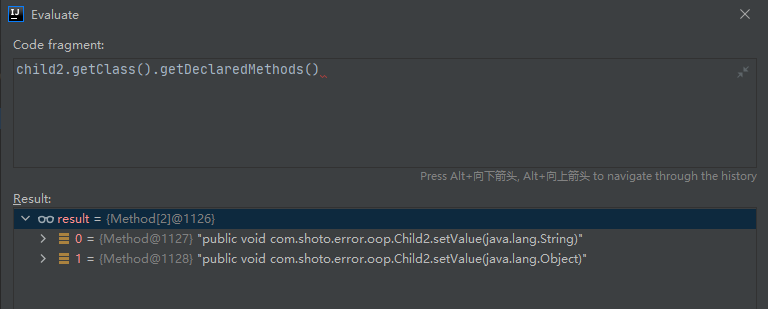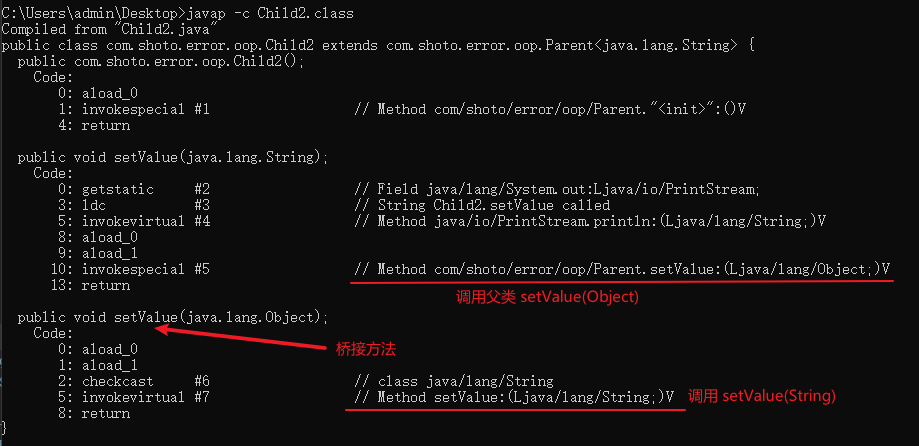接下来,我们就通过几个案例,看看这三大特性结合 OOP 使用时会有哪些坑吧。
1. 反射调用方法不是以传参决定重载
反射的功能包括,在运行时动态获取类和类成员定义,以及动态读取属性调用方法。也就是说,针对类动态调用方法,不管类中字段和方法怎么变动,我们都可以用相同的规则来读取信息和执行方法。因此,几乎所有的 ORM(对象关系映射)、对象映射、MVC 框架都使用了反射。
反射的起点是 Class 类,Class 类提供了各种方法帮我们查询它的信息。接下来,我们先看一个反射调用方法遇到重载的坑:有两个叫 age 的方法,入参分别是基本类型 int 和包装类型 Integer。
1 | 4j |
如果不通过反射调用,走哪个重载方法很清晰,比如传入 36 走 int 参数的重载方法,传入 Integer.valueOf(“36”) 走 Integer 重载:
1 | ReflectionIssueApplication application = new ReflectionIssueApplication(); |
但使用反射时的误区是,认为反射调用方法还是根据入参确定方法重载。比如,使用 getDeclaredMethod 来获取 age 方法,然后传入 Integer.valueOf(“36”):
1 | public class ReflectionDemo { |
输出的日志证明,走的是 int 重载方法:
1 | 22:29:32.154 [main] INFO com.shoto.error.oop.ReflectionIssueApplication - int age = 36 |
其实,要通过反射进行方法调用,第一步就是通过方法签名来确定方法。具体到这个案例, getDeclaredMethod 传入的参数类型 Integer.TYPE 代表的是 int,所以实际执行方法时无论传的是包装类型还是基本类型,都会调用 int 入参的 age 方法。
把 Integer.TYPE 改为 Integer.class,执行的参数类型就是包装类型的 Integer。这时,无论传入的是 Integer.valueOf(“36”) 还是基本类型的 36:
1 |
|
都会调用 Integer 为入参的 age 方法:
1 | 22:31:06.174 [main] INFO com.shoto.error.oop.ReflectionIssueApplication - Integer age = 36 |
现在我们非常清楚了,反射调用方法,是以反射获取方法时传入的方法名称和参数类型来确 定调用方法的。接下来,我们再来看一下反射、泛型擦除和继承结合在一起会碰撞出什么 坑。
2. 泛型经过类型擦除多出桥接方法的坑
Java 编译器对泛型应用了强大的类型检测,如果代码违反了类型安全就会报错,可以在编译时暴露大多数泛型的编码错误。但总有一部分编码错误,比如泛型类型擦除的坑,在运行时才会暴露。接下来,我就和你分享一个案例吧。
有一个项目希望在类字段内容变动时记录日志,于是开发同学就想到定义一个泛型父类,并在父类中定义一个统一的日志记录方法,子类可以通过继承重用这个方法。代码上线后业务没啥问题,但总是出现日志重复记录的问题。开始时,我们怀疑是日志框架的问题,排查到最后才发现是泛型的问题,反复修改多次才解决了这个问题。
父类是这样的:有一个泛型占位符 T;有一个 AtomicInteger 计数器,用来记录 value 字 段更新的次数,其中 value 字段是泛型 T 类型的,setValue 方法每次为 value 赋值时对计数器进行 +1 操作。我重写了 toString 方法,输出 value 字段的值和计数器的值:
1 | public class Parent<T> { |
子类 Child1 的实现是这样的:继承父类,但没有提供父类泛型参数;定义了一个参数为 String 的 setValue 方法,通过 super.setValue 调用父类方法实现日志记录。我们也能明白,开发同学这么设计是希望覆盖父类的 setValue 实现:
1 | public class Child1 extends Parent { |
在实现的时候,子类方法的调用是通过反射进行的。实例化 Child1 类型后,通过 getClass().getMethods 方法获得所有的方法;然后按照方法名过滤出 setValue 方法进行调用,传入字符串 test 作为参数:
1 |
|
运行代码后可以看到,虽然 Parent 的 value 字段正确设置了 test,但父类的 setValue 方 法调用了两次,计数器也显示 2 而不是 1:
1 | Child1.setValue called |
显然,两次 Parent 的 setValue 方法调用,是因为 getMethods 方法找到了两个名为 setValue 的方法,分别是父类和子类的 setValue 方法。
这个案例中,子类方法重写父类方法失败的原因,包括两方面:
一是,子类没有指定 String 泛型参数,父类的泛型方法 setValue(T value) 在泛型擦除后是 setValue(Object value),子类中入参是 String 的 setValue 方法被当作了新方法;
二是,子类的 setValue 方法没有增加 @Override 注解,因此编译器没能检测到重写失败的问题。这就说明,重写子类方法时,标记 @Override 是一个好习惯。
下面学重新实现了 Child2,继承 Parent 的时候提供了 String 作为泛型 T 类型,并使用 @Override 关键字注释了 setValue 方 法,实现了真正有效的方法重写:
1 | public class Child2 extends Parent<String> { |
但很可惜,修复代码上线后,还是出现了日志重复记录:
1 | Child2.setValue called |
可以看到,这次是 Child2 类的 setValue 方法被调用了两次。通过 getDeclaredMethods 查找到的方法一定是来自 Child2 类本身;而且,怎么看 Child2 类中也只有一个 setValue 方法,为什么还会重复呢?
调试一下可以发现,Child2 类其实有 2 个 setValue 方法,入参分别是 String 和 Object。如果不通过反射来调用方法,我们确实很难发现这个问题。其实,这就是泛型类型擦除导致 的问题。我们来分析一下。

我们知道,Java 的泛型类型在编译后擦除为 Object。虽然子类指定了父类泛型 T 类型是 String,但编译后 T 会被擦除成为 Object,所以父类 setValue 方法的入参是 Object, value 也是 Object。如果子类 Child2 的 setValue 方法要覆盖父类的 setValue 方法,那入参也必须是 Object。所以,编译器会为我们生成一个所谓的 bridge 桥接方法,你可以使用 javap 命令来反编译编译后的 Child2 类的 class 字节码:

可以看到,入参为 Object 的 setValue 方法在内部调用了入参为 String 的 setValue 方法,也就是代码里实现的那个方法。如果编译器没有帮我们实现这个桥接方法,那么 Child2 子类重写的是父类经过泛型类型擦除后、入参是 Object 的 setValue 方法。这两个方法的参数,一个是 String 一个是 Object,明显不符合 Java 的语义:
知道这个问题之后,修改方式就明朗了,可以使用 method 的 isBridge 方法,来判断方法是不是桥接方法:
通过 getDeclaredMethods 方法获取到所有方法后,必须同时根据方法名 setValue 和 非 isBridge 两个条件过滤,才能实现唯一过滤;使用 Stream 时,如果希望只匹配 0 或 1 项的话,可以考虑配合 ifPresent 来使用 findFirst 方法。
修复代码如下:
1 |
|
这样就可以得到正确输出了:
1 | Child2.setValue called |
最后小结下,使用反射查询类方法清单时,我们要注意两点:
- getMethods 和 getDeclaredMethods 是有区别的,前者可以查询到父类方法,后者只能查询到当前类。
- 反射进行方法调用要注意过滤桥接方法。
3. 注解可以继承吗?
注解可以为 Java 代码提供元数据,各种框架也都会利用注解来暴露功能,比如 Spring 框架中的 @Service、@Controller、@Bean 注解,Spring Boot 的 @SpringBootApplication 注解。
框架可以通过类或方法等元素上标记的注解,来了解它们的功能或特性,并以此来启用或执行相应的功能。通过注解而不是 API 调用来配置框架,属于声明式交互,可以简化框架的配置工作,也可以和框架解耦。
开发同学可能会认为,类继承后,类的注解也可以继承,子类重写父类方法后,父类方法上的注解也能作用于子类,但这些观点其实是错误或者说是不全面的。我们来验证下吧。
首先,定义一个包含 value 属性的 MyAnnotation 注解,可以标记在方法或类上:
1 | ({ElementType.METHOD, ElementType.TYPE}) |
然后,定义一个标记了 @MyAnnotation 注解的父类 Person,设置 value 为 Class 字符 串;同时这个类的 foo 方法也标记了 @MyAnnotation 注解,设置 value 为 Method 字 符串。接下来,定义一个子类 Student 继承 Person父类,并重写父类的 foo 方法,子类的 foo 方法和类上都没有 @MyAnnotation 注解。
1 | (value = "Class") |
再接下来,通过反射分别获取 Parent 和 Child 的类和方法的注解信息,并输出注解的 value 属性的值(如果注解不存在则输出空字符串):
1 | 4j |
输出如下:
1 | 23:11:47.607 [main] INFO com.shoto.error.oop.AnnotationDemo - ParentClass:Class |
可以看到,父类的类和方法上的注解都可以正确获得,但是子类的类和方法却不能。这说明,子类以及子类的方法,无法自动继承父类和父类方法上的注解。
如果你详细了解过注解应该知道,在注解上标记 @Inherited 元注解可以实现注解的继承。 那么,把 @MyAnnotation 注解标记了 @Inherited,就可以一键解决问题了吗?
1 | ({ElementType.METHOD, ElementType.TYPE}) |
重新运行代码输出如下:
1 | 23:14:54.255 [main] INFO com.shoto.error.oop.AnnotationDemo - ParentClass:Class |
可以看到,子类可以获得父类类上的注解;子类 foo 方法虽然是重写父类方法,并且注解本身也支持继承,但还是无法获得方法上的注解。
如果你再仔细阅读一下@Inherited 的文档就会发现,@Inherited 只能实现类上的注解继承。要想实现方法上注解的继承,你可以通过反射在继承链上找到方法上的注解。但,这样实现起来很繁琐,而且需要考虑桥接方法。
好在 Spring 提供了 AnnotatedElementUtils 类,来方便我们处理注解的继承问题。这个类的 findMergedAnnotation 工具方法,可以帮助我们找出父类和接口、父类方法和接口方法上的注解,并可以处理桥接方法,实现一键找到继承链的注解:
1 |
|
修改后,可以得到如下输出:
1 | 23:21:43.399 [main] INFO com.shoto.error.oop.AnnotationDemo - ChildClass:Class |
可以看到,子类 foo 方法也获得了父类方法上的注解。